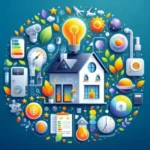In an era where sustainability and cost-effectiveness are more critical than ever, enhancing your home’s energy efficiency is not just a trend—it’s a necessity.
With rising utility bills and increasing environmental concerns, homeowners are seeking practical solutions to minimize their energy consumption while maximizing comfort. Fortunately, improving your home’s energy efficiency doesn’t have to be daunting or expensive. In this blog post, we will explore ten simple yet impactful ways to boost your home’s energy efficiency today. From easy DIY projects and small lifestyle changes to smart technology upgrades, these tips will empower you to reduce your carbon footprint and enjoy a more sustainable living space. Discover how these straightforward strategies can lead to significant savings on your energy bills while creating a cozy and efficient home environment for you and your family.
1. Understanding Energy Efficiency: What It Means for Your Home
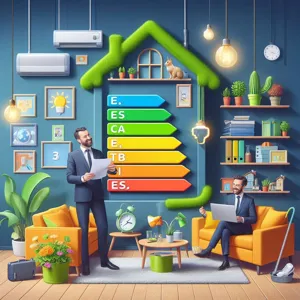
Understanding energy efficiency is the foundation of creating a more sustainable and cost-effective home. At its core, energy efficiency means using less energy to provide the same level of comfort and service. This can be achieved through various strategies and improvements that minimize energy waste while maximizing the effectiveness of your home’s systems.
When you think about energy efficiency, envision a home that maintains a comfortable temperature year-round without requiring excessive heating or cooling. It’s about optimizing insulation, sealing leaks, and utilizing energy-efficient appliances and lighting. Each of these elements plays a crucial role in reducing energy consumption and lowering utility bills.
Consider your appliances: older models can consume significantly more energy than their modern, energy-efficient counterparts. By upgrading to Energy Star-rated appliances, you not only reduce your carbon footprint but also enjoy savings that can add up over time. Similarly, switching to LED lighting can decrease your electricity usage dramatically, all while providing better illumination and lasting longer than traditional bulbs.
Insulation is another vital aspect to consider. Properly insulating your home keeps the warm air in during winter and the cool air in during summer, reducing the need for constant heating and cooling. Similarly, sealing cracks and gaps around windows and doors can prevent unwanted drafts, ensuring that your HVAC system operates more efficiently.
Understanding energy efficiency is more than just making changes; it’s about adopting a holistic approach that embraces smart choices. By prioritizing energy-efficient practices, you’ll not only enhance the comfort of your home but also contribute to a healthier planet and a more sustainable future. With a clear understanding of what energy efficiency entails, you’re well on your way to implementing practical solutions that can lead to significant savings and a more eco-friendly lifestyle.
2. Conducting an Energy Audit: Assessing Your Current Consumption
Conducting an energy audit is a crucial step in boosting your home’s energy efficiency, and it’s easier than you might think. This systematic assessment not only highlights how much energy your home consumes but also identifies areas where you can make impactful changes.
Start by gathering your utility bills over the past year. This will give you a baseline to understand your energy usage patterns. Next, take a tour of your home, paying close attention to windows, doors, insulation, and appliances. Look for drafts around windows and doors; even the smallest gaps can lead to significant energy loss. Make a note of any appliances that seem outdated or inefficient—these could be major contributors to your energy bill.
If you want a more thorough evaluation, consider hiring a professional energy auditor. They use specialized equipment like blower doors and thermal cameras to pinpoint areas of heat loss that you might miss. These experts can provide tailored recommendations, whether it’s adding insulation, sealing ducts, or upgrading to energy-efficient appliances.
In addition to assessing your home’s structure, don’t forget to evaluate your habits. Are you leaving lights on in rooms that aren’t in use? Is your thermostat set too high in the summer or too low in the winter? Small behavioral changes can complement the physical improvements you make.
Once you’ve completed your audit and identified areas for improvement, prioritize your findings based on cost, impact, and feasibility. Taking action on even a few of these recommendations can lead to immediate savings on your energy bills and a more comfortable living environment. Remember, improving your home’s energy efficiency not only benefits your wallet but also contributes to a healthier planet.
3. Sealing Air Leaks: Tips for Windows and Doors
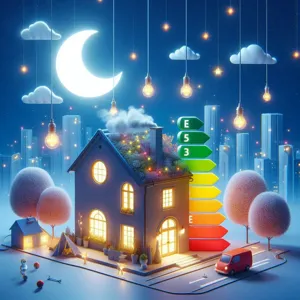
Sealing air leaks around your windows and doors is one of the most effective and often overlooked strategies for enhancing your home’s energy efficiency. Drafty areas can significantly undermine your heating and cooling efforts, leading to higher energy bills and an uncomfortable living environment. By addressing these leaks, you not only conserve energy but also maintain a consistent temperature throughout your home.
Start by conducting a simple inspection. On a windy day, use a candle or an incense stick to identify drafts. Move the flame or smoke around the edges of your windows and doors, paying attention to any flickering or movement. This method will help you pinpoint where the air is escaping.
Once you’ve identified the trouble spots, it’s time to seal them up. For windows, consider using weatherstripping, which comes in various materials like foam, vinyl, and felt. These strips can be easily applied to the sides of the window frames, creating a snug barrier against drafts. Alternatively, for older windows that need a bit more attention, you might want to apply caulk to fill in gaps and cracks. Make sure to choose a caulk that is appropriate for the material of your window frame—silicone-based caulk works well for both interior and exterior applications.
For doors, the process is similar. Install a door sweep at the bottom of the door to block drafts coming from underneath. Adding or replacing weather stripping around the door frame is equally important to ensure a tight seal. You can also use a door snake or draft stopper when the door is not in use for an extra layer of protection.
As you seal these leaks, you’ll not only see a decrease in your energy bills but also a more comfortable living space. This simple yet impactful change can lead to improved indoor air quality and reduce the workload on your heating and cooling systems, ultimately extending their lifespan. Making the effort to seal air leaks today can yield significant benefits for your home’s energy efficiency tomorrow.
4. Insulating Your Home: Best Practices for Maximum Retention
Insulating your home is a fundamental step in enhancing energy efficiency, and implementing best practices can lead to significant improvements in temperature retention and comfort. Proper insulation acts as a barrier, keeping the warmth in during the chilly months and blocking the heat during the summer, which means your heating and cooling systems won’t have to work as hard, resulting in lower energy bills.
Start by assessing the areas in your home that require insulation. The most common locations include the attic, walls, and floors. In the attic, where heat can escape easily, consider using fiberglass batts or blown-in cellulose to fill gaps and create a thick, protective layer. Make sure to pay attention to any air leaks around vents, chimneys, and other openings as these can undermine your insulation efforts.
For walls, if you have an older home with little to no insulation, you can opt for foam board insulation or blown-in materials. Insulating your walls not only improves energy efficiency but also enhances soundproofing, creating a quieter living environment. Additionally, don’t forget about your basement and crawl spaces; insulating these areas can prevent cold drafts from seeping into your home and protect against moisture issues.
Also, consider using high-performing insulation materials that offer better R-values—this measures the effectiveness of insulation. Materials such as spray foam insulation can expand to fill gaps and provide a superior seal, but traditional options like fiberglass and mineral wool are also effective and more budget-friendly.
Lastly, ensure that your insulation is installed correctly. Poor installation can lead to cold spots and reduced efficiency, negating the benefits of your investment. Whether you’re tackling the project yourself or hiring a professional, make sure to follow best practices to maximize retention and create a cozy, energy-efficient home that saves you money in the long run. By prioritizing insulation, you’ll not only boost your home’s comfort but also contribute to a more sustainable environment.
5. Upgrading to Energy-Efficient Appliances: What to Look For
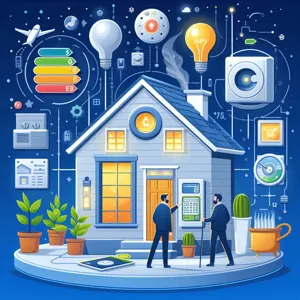
Upgrading to energy-efficient appliances is one of the most impactful steps you can take toward enhancing your home’s energy efficiency. Not only do these appliances help reduce your carbon footprint, but they also significantly lower your utility bills, making them a smart investment for both your wallet and the environment. However, with a plethora of options available, it’s essential to know what to look for when selecting new appliances.
First and foremost, seek out the ENERGY STAR label. This symbol indicates that the appliance meets strict energy efficiency guidelines set by the U.S. Environmental Protection Agency. ENERGY STAR-certified products are rigorously tested and proven to use less energy without sacrificing performance, which means you can feel confident that you’re making a responsible choice.
Next, consider the size and capacity of the appliance. Larger models may seem appealing, but an oversized appliance can lead to wasted energy. Always choose the right size for your household’s needs. For instance, a family of four might benefit from a larger refrigerator, while a single-person household may opt for a compact model to save energy.
Additionally, pay attention to the appliance’s energy consumption ratings. Many appliances come with a yellow EnergyGuide label that provides an estimate of how much energy they use per year. Compare these ratings across different models to find an option that offers the best efficiency for your needs.
Also, don’t overlook the importance of features that enhance efficiency. Look for appliances that come with smart technology, which can optimize energy use based on your habits. For instance, a smart thermostat can adjust your heating and cooling based on your schedule, significantly reducing unnecessary energy consumption.
Finally, think about the long-term savings. While energy-efficient appliances may have a higher upfront cost, the savings on your energy bills can quickly offset these expenses. In many cases, the return on investment becomes evident within just a few years.
By upgrading to energy-efficient appliances, you’re not only taking a significant step towards improving your home’s energy efficiency but also contributing to a more sustainable future. With careful consideration and research, you can choose appliances that align with your lifestyle while minimizing your environmental impact.
6. Switching to LED Lighting: Benefits and Savings
Switching to LED lighting is one of the most straightforward yet impactful changes you can make to boost your home’s energy efficiency. Unlike traditional incandescent bulbs, LEDs (Light Emitting Diodes) are designed to consume significantly less energy while providing the same, if not better, quality of light. In fact, they use up to 75% less energy than incandescent bulbs and can last up to 25 times longer, translating to substantial savings over time.
The benefits of LED lighting extend beyond just lower energy bills. LEDs are available in a variety of color temperatures, allowing you to create the perfect ambiance for any room. Whether you prefer a warm, cozy glow in your living room or bright, crisp lighting in your kitchen, there’s an LED bulb that meets your needs. Plus, they emit very little heat compared to incandescent bulbs, making them safer to use, especially in enclosed fixtures.
Another compelling reason to make the switch is their environmental impact. By reducing energy consumption, you’re also decreasing your carbon footprint. LEDs are made from non-toxic materials and are 100% recyclable, further contributing to a more sustainable home.
Installing LED lighting is an easy DIY project that can be completed in a matter of minutes. Simply replace old bulbs with LED alternatives, and you’ll instantly start reaping the benefits. As your home becomes more energy-efficient, you’ll not only notice lower utility bills but also enjoy a more comfortable and inviting space. Embrace this simple change today, and watch how it transforms both your home and your wallet!
7. Smart Thermostats: How They Can Optimize Your Energy Use
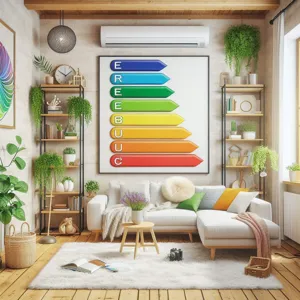
Smart thermostats are revolutionizing the way we manage energy consumption in our homes, making them an essential tool for anyone looking to enhance their energy efficiency. Unlike traditional thermostats, which require manual adjustments and constant monitoring, smart thermostats leverage advanced technology to learn your preferences and adapt accordingly.
Imagine coming home to a perfectly heated or cooled space without having to lift a finger. These devices can be programmed to adjust the temperature based on your routines, optimizing energy use when you’re away and ensuring comfort when you’re home. For instance, if you typically leave for work at 8 a.m. and return at 6 p.m., a smart thermostat can lower or raise the temperature during those hours, preventing unnecessary energy waste.
Additionally, many smart thermostats can be controlled remotely via smartphone apps, allowing you to make adjustments on the go. This feature is particularly useful for unplanned changes in your schedule, so you can ensure your home is at the ideal temperature upon your arrival.
Moreover, these devices often provide detailed insights into your energy consumption patterns, helping you identify trends and areas for improvement. Some models even offer energy-saving tips tailored to your usage, empowering you to make informed decisions that further reduce your carbon footprint and utility bills.
With features like geofencing, which detects your location and adjusts the temperature accordingly, and integration with smart home systems, smart thermostats are not just a luxury—they are a smart investment for enhancing your home’s energy efficiency. Transitioning to a smart thermostat can lead to significant savings over time, making it a step worth considering for any homeowner looking to create a more sustainable living environment.
8. Utilizing Natural Light: Strategies for Brighter Spaces
Harnessing natural light is one of the simplest and most effective ways to enhance your home’s energy efficiency while creating a warm and inviting atmosphere. By maximizing the light that flows through your spaces, you can reduce reliance on artificial lighting, lower your energy bills, and improve your overall well-being.
Start by evaluating your current lighting setup. Are there areas in your home that feel dim or closed off? Consider rearranging furniture or removing obstructions that block windows and light sources. A well-placed mirror can also work wonders—positioned strategically, it can reflect sunlight deeper into a room, instantly brightening the space without any added electricity.
Incorporate lighter color palettes for your walls and furnishings. Light colors naturally reflect sunlight, enhancing the brightness of your interiors. Adding sheer or light-filtering window treatments can also allow soft sunlight to illuminate your home while still providing privacy.
If you’re considering renovations, think about installing skylights or larger windows. Skylights are particularly effective in rooms that tend to be darker, such as kitchens or bathrooms, allowing for an influx of natural light that can transform these spaces. Larger windows not only create a more open feel but also provide stunning views of the outdoors, connecting your living space to nature.
Finally, don’t overlook the power of plants. Strategically placed greenery can improve air quality while adding life and vibrancy to your home. Consider using window sills for herbs or small indoor plants that thrive in sunlight, creating a beautiful and functional display.
By embracing natural light, you not only create a brighter and more pleasant living environment but also take significant steps toward a more energy-efficient home. Simple adjustments in how you utilize light can lead to remarkable changes in both your mood and your energy consumption.
9. Water Conservation Techniques: Improving Efficiency in the Bathroom
Water conservation in the bathroom is a crucial yet often overlooked aspect of enhancing your home’s energy efficiency. With bathrooms being some of the most water-intensive spaces in a household, implementing effective conservation techniques can lead to significant savings on both your water bills and energy consumption.
Start by inspecting your fixtures. Low-flow toilets and showerheads are game-changers; they can reduce water usage by as much as 50% without sacrificing performance. If your toilet is older, consider installing a dual-flush system, which allows you to choose between a full or half flush depending on your needs. This simple upgrade can make a notable difference in your daily water consumption.
Next, focus on your shower. By taking shorter showers and turning off the water while lathering up or shampooing, you can save gallons of water daily. If you’re up for a DIY project, you might also consider adding a flow restrictor to your showerhead, limiting the amount of water that flows through without diminishing the pressure.
Don’t forget about your faucet! Installing aerators on your sink faucets can reduce flow rates significantly while maintaining that satisfying feel of high pressure. Combine this with mindful habits—like filling a basin for shaving or washing your face instead of running the tap—and you’ll be amazed at how quickly water savings add up.
Lastly, check for leaks. A dripping faucet or a running toilet can waste hundreds of gallons of water each year. Regularly inspect your plumbing and make repairs as soon as you notice any issues.
By adopting these simple water conservation techniques in your bathroom, you’ll not only contribute to a more sustainable future but also enjoy the benefits of reduced utility bills and a more eco-friendly home. Every drop counts, and each small change can lead to a more efficient and responsible household.
10. Landscaping for Energy Efficiency: Using Nature to Your Advantage
Landscaping for energy efficiency is a powerful yet often overlooked strategy that can significantly reduce your home’s energy consumption while enhancing its aesthetic appeal. By thoughtfully designing your outdoor space, you can create a natural barrier against the elements, helping to regulate your home’s temperature and ultimately lowering your energy bills.
Start by considering the placement of trees and shrubs. Deciduous trees strategically planted on the south and west sides of your home can provide essential shade during the summer months, reducing the need for air conditioning. Their broad canopies block direct sunlight, keeping your home cooler while still allowing sunlight to filter through in the winter after the leaves have fallen. Evergreen trees, on the other hand, can serve as windbreaks, shielding your home from harsh winter winds and helping to retain heat.
In addition to trees, incorporating shrubs and hedges around your property can further enhance insulation. A well-placed row of shrubs can act as a natural sound barrier, reduce heat loss, and provide an added layer of protection from drafts. Ground cover plants, such as creeping thyme or clover, can also help to retain moisture in the soil, reducing the need for excessive watering in your garden.
Moreover, consider integrating native plants into your landscape. These plants are adapted to your local climate and require less water and maintenance than non-native species, thus promoting sustainability and reducing your overall environmental impact. Native plants also attract beneficial wildlife, such as pollinators, which can enhance your garden’s health and beauty.
Finally, don’t forget about hardscaping elements like patios, walkways, and retaining walls. Using permeable materials can help manage rainwater runoff, which is beneficial for your landscaping and the broader environment. Incorporating natural stones or gravel not only adds to the visual appeal but can also create microclimates around your home, further supporting your energy efficiency goals.
By thoughtfully incorporating these landscaping principles, you can transform your outdoor space into an energy-efficient haven that works harmoniously with nature, providing comfort and savings for years to come.
11. Regular Maintenance: The Key to Sustaining Energy Efficiency
Regular maintenance is often the unsung hero of home energy efficiency. Just as a well-oiled machine runs smoothly, a home that is properly maintained operates at peak efficiency, saving you both energy and money. Over time, wear and tear can lead to inefficiencies that silently drain your resources. This is especially true for systems like heating, ventilation, and air conditioning (HVAC) units, which require periodic check-ups to ensure they are running optimally.
Start by scheduling seasonal inspections for your HVAC system. A technician can clean filters, check for leaks, and ensure that your system is functioning efficiently. This not only extends the life of your equipment but also significantly enhances its performance, keeping your home comfortable year-round.
Don’t overlook your home’s insulation and sealing either. Regularly check for drafts around windows and doors, and replace weather stripping as needed. Inspect your attic and crawl spaces for any gaps or deteriorated insulation that could lead to heat loss in the winter or cool air escaping in the summer. These small repairs can lead to significant savings on your energy bills.
Furthermore, consider servicing your appliances regularly. Refrigerators, dishwashers, and washing machines that are well-maintained consume less energy. Clean the coils on your refrigerator and ensure your dishwasher’s spray arms are free from debris for optimal performance.
By committing to a routine maintenance schedule, you not only improve your home’s energy efficiency but also enhance its overall comfort and longevity. Regular upkeep is an investment in your home that pays dividends in both energy savings and peace of mind. Remember, a proactive approach today can lead to a significantly more efficient home tomorrow.
12. Educating Your Household: Encouraging Energy-Saving Habits
Educating your household about energy-saving habits is one of the most effective ways to enhance your home’s energy efficiency. It’s not just about implementing new technologies or making physical changes to your living space; it’s also about fostering a culture of awareness and responsibility among all members of your family. Start by holding a family meeting to discuss the importance of energy conservation—not just for the planet, but also for lowering utility bills and improving overall comfort at home.
Lead by example. Show your family how simple changes in daily routines can make a significant impact. For instance, encourage everyone to turn off lights in unoccupied rooms, unplug devices that aren’t in use, and use natural light whenever possible. You might even consider creating a friendly competition to see who can come up with the most creative energy-saving ideas or who can reduce their energy usage the most in a month.
Incorporate fun educational tools, like energy-saving challenges or DIY projects, to engage younger household members. For example, you could help them set up a chore chart that rewards them for remembering to close doors and windows or for helping to switch off appliances. This not only teaches responsibility but also instills lifelong habits that will benefit them and the environment.
To deepen their understanding, provide information on how energy consumption impacts the environment and discuss the benefits of renewable energy sources. Share articles, documentaries, or even invite them to participate in local community events focused on sustainability.
Ultimately, educating your household about energy-saving habits is about creating a collective mindset that prioritizes efficiency. When everyone is on board, the cumulative effect can lead to significant energy savings, fostering a sense of teamwork and shared accomplishment as you all work toward a more sustainable and eco-friendly home.
13. Exploring Renewable Energy Options: Solar Panels and More
As the world increasingly shifts towards sustainable living, exploring renewable energy options for your home has never been more pertinent. One of the most popular choices is solar energy, harnessed through solar panels that convert sunlight into electricity. Imagine your roof adorned with sleek, modern panels, quietly capturing sunlight during the day and converting it into energy that powers your home. Not only does this reduce your reliance on traditional energy sources, but it can also significantly lower your utility bills over time.
Installing solar panels is an investment that can pay off in multiple ways. Many states offer tax incentives and rebates for homeowners who choose to go solar, making the initial costs more manageable. Additionally, depending on your location, you might even have the opportunity to sell excess energy back to the grid, providing you with an extra source of income while contributing to a more sustainable environment.
But solar panels aren’t the only renewable energy option available. Wind turbines, for instance, can be an excellent choice if you live in a windy area. Small, residential wind turbines can generate substantial energy, complementing your solar setup and further reducing your carbon footprint. Geothermal heating and cooling systems are another option, utilizing the earth’s stable underground temperature to maintain comfortable indoor climates year-round.
As you consider these renewable energy options, think about the long-term benefits they bring—not only to your wallet but also to the planet. By making the switch to renewable energy, you’re not just enhancing your home’s energy efficiency; you’re also taking a proactive step towards a cleaner, greener future. Whether you choose solar panels, wind turbines, or geothermal systems, investing in renewable energy is a powerful way to boost your home’s efficiency and contribute to global sustainability efforts.
14. Financial Incentives: Tax Credits and Rebates for Energy Efficiency
When it comes to boosting your home’s energy efficiency, financial incentives are a powerful ally. Many homeowners are unaware that there are numerous tax credits and rebates available that can significantly offset the costs of energy-saving upgrades. These incentives can range from federal tax credits for renewable energy systems to local utility rebates for energy-efficient appliances and home improvements.
For instance, if you decide to install solar panels on your roof, you could benefit from a federal tax credit covering a percentage of the installation costs. These credits can dramatically reduce the upfront investment needed to make the switch to clean energy. Similarly, many states offer rebates for energy-efficient HVAC systems, insulation, and windows, making it more affordable to enhance your home’s energy performance.
To take full advantage of these programs, it’s essential to do your homework. Start by researching the specific incentives available in your state or locality. Websites like the Database of State Incentives for Renewables & Efficiency (DSIRE) provide comprehensive information on a variety of programs, helping you identify which upgrades qualify for financial assistance.
Additionally, remember to keep track of all your receipts and paperwork related to the improvements you make. Many incentives require documentation to verify eligibility. By staying organized, you can ensure you receive the maximum benefits possible.
Incorporating energy-efficient upgrades into your home not only reduces your environmental footprint but can also lead to significant savings in monthly utility bills. When you combine these long-term savings with immediate financial incentives, you’ll find that investing in energy efficiency is not just good for the planet—it’s a smart financial move as well. Don’t miss out on the opportunity to make your home more efficient while keeping extra cash in your pocket!
15. Conclusion: The Long-Term Benefits of a More Energy-Efficient Home
In conclusion, investing in energy efficiency is not just a trend; it’s a long-term commitment to enhancing your home’s sustainability while simultaneously reaping a multitude of benefits. By implementing the simple strategies we’ve discussed, such as improving insulation, upgrading to energy-efficient appliances, and utilizing smart home technology, you are not only contributing to a healthier planet but also creating a more comfortable living environment for you and your family.
The long-term financial savings are particularly compelling. While some energy-efficient upgrades may require an initial investment, the reduction in utility bills can lead to significant savings over time. Many homeowners report a noticeable drop in their monthly expenses, allowing for more financial freedom to allocate funds towards other priorities or investments. Plus, many energy-efficient products come with rebates and incentives that can further offset costs.
Beyond the financial aspect, a more energy-efficient home enhances your property value. As buyers become increasingly conscious of environmental impact, homes with energy-efficient features are often more desirable in the real estate market. This not only makes your home easier to sell but can also fetch a higher price.
Moreover, an energy-efficient home contributes to a more sustainable future. By reducing your carbon footprint, you are playing a role in combatting climate change and promoting a healthier environment for future generations. Every small change contributes to a larger impact, and as more homeowners embrace energy efficiency, the collective effect can lead to significant improvements on a global scale.
Lastly, let’s not overlook the comfort factor. Energy-efficient homes maintain more consistent temperatures, leading to a more pleasant living space year-round. Not only will you enjoy the benefits of lower bills and increased value, but you’ll also savor the comfort of a well-regulated home.
In essence, the journey towards energy efficiency is not just about immediate gains; it’s about envisioning a more sustainable, financially sound, and comfortable future. So take those first steps today, knowing that every action you take is a stride towards a better home and a healthier planet.
In conclusion, enhancing your home’s energy efficiency doesn’t have to be a daunting task; it can be as simple as implementing a few of the strategies we’ve discussed in this post. From sealing drafts and upgrading to energy-efficient appliances to embracing smart home technology, each step you take not only contributes to a smaller carbon footprint but also leads to significant savings on your energy bills. Making your home more energy-efficient is an investment in both the environment and your wallet. We encourage you to start with one or two of these tips today, and watch as your home transforms into a more sustainable and cost-effective space. Thank you for joining us on this journey toward a greener home—let’s take these steps together for a brighter, more energy-efficient future!



